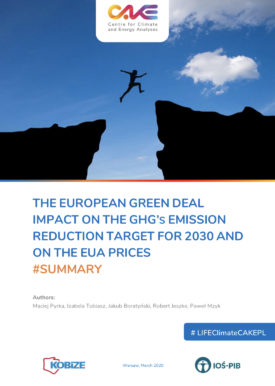ANALYSIS: European Green Deal impact on the GHG’s emission reduction target for 2030 and on the EUA prices
We are pleased to present the results of our new analysis prepared as part of the LIFE Climate CAKE PL project entitled “The European Green Deal impact on the GHG’s emission reduction target for 2030 and on the EUA prices. Summary” The full version of the publication is in Polish and the summary is in English.
- „Zmiana celów redukcyjnych oraz cen uprawnień do emisji wynikająca z komunikatu Europejski Zielony Ład” – Full analysis in Polish
 CAKE_Zmiana-celów-redukcyjnych-i-cen-uprawnień-do-emisji-wynikająca-z-komunikatu-Europejski-Zielony-Ład.pdf (1.3 MiB, 3,061 hits)
CAKE_Zmiana-celów-redukcyjnych-i-cen-uprawnień-do-emisji-wynikająca-z-komunikatu-Europejski-Zielony-Ład.pdf (1.3 MiB, 3,061 hits)
- “The European Green Deal impact on the GHG’s emission reduction target for 2030 and on the EUA prices. Summary” – Summary in English
 CAKE_The-European-Green-Deal-impact-on-the-reduction-target-for-2030-and-on-the-EUA-prices.-Summary.pdf (1.0 MiB, 2,356 hits)
CAKE_The-European-Green-Deal-impact-on-the-reduction-target-for-2030-and-on-the-EUA-prices.-Summary.pdf (1.0 MiB, 2,356 hits)
 The above analysis is of particular importance in the context of the need to achieve the 2050 climate neutrality objective and the challenges of a just transition.
The above analysis is of particular importance in the context of the need to achieve the 2050 climate neutrality objective and the challenges of a just transition.
The EC’s proposals to tighten climate and energy policy under the European Green Deal and the new European Climate Law project announced today will have a great impact on the European industry and energy sectors, which will bear the very high costs of this transformation. This will particularly affect Poland, whose energy is based on fossil fuels.
In this report has been analysed how increasing the reduction target to 50% and 55% from the current 40% in 2030 may change the reduction of emissions. This concerned sectors covered by the EU emissions trading system (EU ETS) and sectors that are outside this system, i.e. in the non-ETS. It was also examined how new reduction targets for 2030 affect the price of EUA (European Union Allowances).
Below are the most important conclusions from the analysis:
EU ETS
- Adopting a higher target than the current 40% in the EU will result in a significant increase in the price of emission allowances in the EU ETS. If the new target is 50%, prices of allowances will rise up to 34 euro/EUA and 52 euro/EUA in 2025 and 2030 respectively. The consequence of raising the reduction target to 55% will be an increase in the price of allowances to 41 euro/EUA and 76 euro/EUA.
- Total cost of purchasing allowances for installations covered by the EU ETS in 2030 will range from EUR 10 billion to EUR 18 billion for a 50% and 55% reduction target respectively.
- New reduction targets will also reduce the number of allowances to zero around 2042-2045 (for a 50% and 55% reduction target respectively). This is the result of an increase in the linear reduction factor (LRF) from current 2,2% to 3.2% or 3.7%. This means that the system will not introduce any new allowances at primary auctions and will not be allocated to industrial sectors.
- In addition, the increase in the price of allowances will have the greatest impact on the energy sector in the EU,will results in a faster withdrawal of fossil fuels from electricity production, and their replacementmainly by renewable energy sources. It is estimated that the share of fossil fuels in electricity generation will decrease by 18% and 30% for the 50% and 55% reduction targets, respectively.
Non-ETS
- In the non-ETS sectors it will be necessary to set new reduction targets between Member States. This will translate into a reduction in AEA (Annual Emission Allocation) limits. Over the 2021-2030 period the average reduction in the Member States’s limits would be 9% and 14% (for a 50% and 55% reduction target respectively). In case of Poland, the average decrease in the non- ETS emission limit during this period will be 2% and 5%, respectively.
- Current reduction target for Poland in the non-ETS sectors is -7% compared to 2005 emissions. This is a difficult goal to achieve, given that in the period 2013-2020 Poland has the right to increase emissions in non-ETS by +14% compared to 2005. Thus, achieving in 2030 even higher reduction targets, which for Poland are -11% and -16% can be a huge challenge.

 Reset ustawień
Reset ustawień Kontrast
Kontrast Widok
Widok Czytelność
Czytelność Czcionka
Czcionka Znaki
Znaki Interlinia
Interlinia Słowa
Słowa Akapity
Akapity Deklaracja dostępności
Deklaracja dostępności









